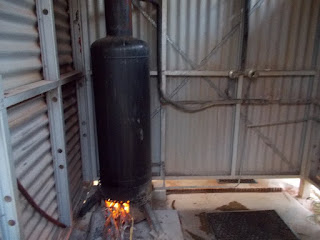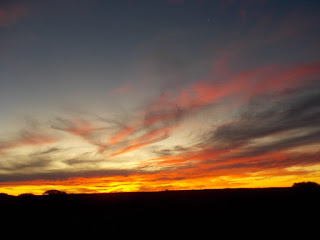Off to Laverton to meet our travelling companions, Beth & John. We had a pleasant drive here this morning travelling on the old Laverton road. We stopped at various Lookouts and drove through a couple of old gold mining towns. In Mt Morgans the only well cared for building was the very old Municipal Chambers. The area was opened up for gold in the late 1890s. Mullock heaps both very large and very small were constantly part of the scenery. It is fascinating to see the display of earth colours which have been piled to make a mullock heap...colours ranging from grey green, through orange, grey to chocolate brown.
After finding Beth & John at the Caravan Park we enjoyed a picnic lunch together before spending a couple of hours shopping and filling EC with fuel and water so we will be ready to leave in the morning. My refrigerator is full to the door. It will require patience to find everything when needed.
There are many prospectors staying in the park. Some keen gold enthusiasts come to the area each year for several months of gold detecting. The elderly chap in the next caravan showed us his finds of gold. He had a small nugget about 3 cm x 2 cm. It is a new and interesting skill to learn. However I do nor intend taking it up as a hobby.
This evening we walked along the street to the local hotel- the Desert Inn. There were 2 bars for purchasing beer. This is rather confronting especially when aboriginal women and children wait at the door of the Pub. We spoke to them as we entered. There is definitely a saddening divide.
The meal was good but far too large for me. I hope there is walking to be done tomorrow. We will be up, up and away in the morning as we begin this long trip. We are looking forward to traversing the Great Victoria desert again. Hopefully there will be some wild flowers. We will be away from Telstra connection for some days so my blogs will not be posted. Ilkurka is 900 km from here and will be the first place where fuel will be available for purchase. There is a small store at this junction/ John and I visited there about 3 years ago. Internet connection was available but the situation may have changed since then.
 |
| Brightly coloured rocks near Leonora |
 |
| June & John with Beth & John at the Desert Inn, Laverton |












































